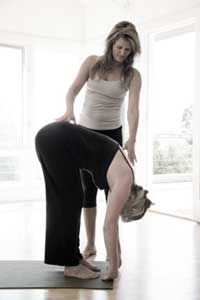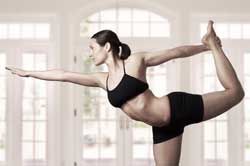
By MEGAN SENGER
Yoga—is it an ancient philosophy, modernized fitness trend or booming business? Arguably, at least in North America, it is probably a combination of all three. As the present-day, Westernized yoga industry continually evolves, the definition of what yoga is—and who should be teaching it—does not come with an easy answer.
However, its popularity is assured. Stress reduction through fitness is one of ACE’s top 10 fitness trends of 2011. And in its modern incarnation, yoga itself is a proven money-maker. Yoga Journal's 2008 “Yoga in America” Market Study concluded that 15.8 million Americans practice yoga—700,000 fewer than in 2004. Yet despite the decreased participation, yoga brought in the bucks: Actual spending on yoga classes and products grew from $2.95 billion (2004) to $5.7 billion (2008), according to the Yoga Journal poll.

The Sutras Summarized
“What makes yoga ‘yoga,’ in the classical definition of the Yoga Sutras, is being focused in the moment to the point where the mind stops fluctuating,” says yoga pro Sage Rountree. “Students often achieve this sense of still focus [through a physical yoga practice] whether or not their instructor explicitly discusses yoga energetics or philosophy.”
Such philosophy is largely derived from the classic text, the Yoga Sutras, believed to be written around 2,000 years ago by the Indian sage Patanjali. It outlines an eight-limbed yogic path: the yamas (moral restraints, such as non-violence and truthfulness), niyamas (individual observances, such as self-discipline and self-study), asana (physical postures), pranayama (mindful breathing), pratyahara (inward focus), dharana (concentration), dhyani (meditation) and samadhi (absorption).
Although the third limb,
asana, is the most visible face of modern North American yoga, many yogis argue that the physical postures really exist to help develop an inward focus that supports the other seven limbs. Indeed, there is great variety in how much individual yoga practitioners follow—or even have knowledge of—the
Yoga Sutras or other influential yogic texts.
Thus as a fitness professional, you may sometimes feel inspired—or compelled—to include a few yoga poses in client workouts. But is yoga just exercise? Should it be? Who is qualified to teach yoga—whether it’s a whole class or a few poses? While these questions can be difficult to answer, it is essential that fitness pros have a general knowledge of yoga’s current debates so they can help their clients benefit from this popular mind-body discipline.
The Philosophical Approach
“When people in the West say ‘yoga,’ they’re commonly referring to hatha yoga, one branch of this ancient discipline that focuses on physical postures, breathing exercises and meditation,” says Carol Krucoff, an ACE-certified Personal Trainer and yoga therapist based in Chapel Hill, N.C., and the author of Healing Yoga for Neck and Shoulder Pain (New Harbinger, 2010).
While the present-day, populist definition of yoga may veer toward “flexibility-oriented exercise class”—especially in a gym setting—its theoretical traditions run much deeper. Although it is impossible to exhaustively discuss all sacred texts and conceptual branches of yoga with brevity, the short summary that follows is intended to touch on the major concepts of yogic philosophy that your yoga-faring clients may encounter from more traditional instructors.
Evidence of yogic concepts—albeit not necessary the practice of physical asanas, or postures—goes back some 5,000 years. While not itself a religion, over time yoga has sometimes intermingled with Hinduism, Buddhist philosophies and Ayurveda (the traditional medicine of India). And of central importance to many yoga practitioners, also known as yogis, are the concepts of the Yoga Sutras, a written summary, or “sacred text,” on how to live a yogic life (see sidebar, “The Sutras Summarized”).
Among those within the traditional yoga community, such sacred writings spawn debates that may be unfamiliar to most fitness pros. For example, despite the billions of dollars spent on yoga each year, many yoga devotees believe that commercially commodifying the practice contradicts its true philosophies. Thus, some yoga teachers believe classes should be free to all, although others see charging money for their time as a fair exchange.
As with any written set of values, analyses of the philosophies outlined in the Yoga Sutras and other sacred texts vary between translators, scholars and devotees. What follows are some discussions and interpretations that are shaping the definition of modern-day yoga.
Is Yoga Just a Workout? Can it Be?
For some enthusiasts, yoga is “just exercise;” that is, the physical practice of yoga postures devoid of any spiritual element. Indeed, the marketing of yoga is frequently based on images of chiseled, athletic bodies in exceedingly acrobatic poses. (For example, clothing brand HardTail Forever’s 2009 advertising campaign)
However, others strongly believe that a true yoga practice must include an inward, spiritual dimension, and that focusing solely on developing tight abs or a “yoga butt” are contrary—even offensive—to yoga’s true meaning.
“I think when we are trying to make yoga ‘just exercise,’ perhaps with the intention of making it more accessible to a gym-going clientele, we are doing everyone a disservice, and really just providing a stretch-and-strengthen mat class,” says Robin Armstrong, D.C., a chiropractor and yoga teacher trainer who runs a Vancouver, B.C.–based yoga therapy practice.

Krucoff agrees that “physical postures–only” yoga falls short. “Yoga is not just an exercise system. It’s an energetic system and a spiritual discipline designed to quiet the mind. If [a yoga] teacher only teaches the physical postures, without instruction in the mental, emotional and spiritual aspects involved in the practice—then it’s ‘yoga-flavored exercise.’”
But is “yoga-flavored exercise” a bad thing if that’s what consumers want? Not according to Kimberly Fowler, J.D., founder and CEO of YAS Fitness Centers in Southern California. Her studios offer spinning and yoga classes that eschew traditional yogic elements that may seem intimidating to the uninitiated, such as the use of Sanskrit language terms for yoga postures or the chanting of ‘ohms’ during class. Fowler—the author of The No OM Zone: A No-Chanting, No-Granola, No-Sanskrit Practical Guide to Yoga (Rodale, 2010)—strongly contends that “yoga can be just a workout. My style of yoga is called Yoga for Athletes.”
“Yes, yoga can be just exercise,” agrees Brenda Wong, the Operations and Logistics Manager for YogaFit in Torrance, Calif. The company was founded in 1994 by Beth Shaw and seeks to bridge the gap between the challenges of teaching in health clubs versus private yoga studios. A continuing education partner with ACE, YogaFit offers traditional Yoga Alliance–approved 200-hour trainings (more on Yoga Alliance to follow), as well as one-, two- and four-day workshops for all types of fitness pros, which address topics as varied as yoga for kids, yoga for golf and tennis, and yoga for personal trainers.
Even traditional teachers may see value in making yogic philosophy an optional or less prominent part of class. “I don't believe that as yoga teachers we have to emphasize the traditional philosophical aspects of yoga in order for it to be of benefit to people physically,” says Terra Gold, L.Ac., D.O.M., a trainer of yoga teachers, a licensed acupuncturist and co-founder of Yoga Doctors Mandiram in Los Angeles, Calif. She adds that the physical postures are often a doorway for yoga to become more than just a workout for some people, and are a non-intimidating introduction into other aspects of yoga for those who become interested.
Regardless of how a teacher approaches the physical practice of yoga, it is of interest to know what kind of education and biomechanical training such an instructor receives—and whether it is enough to meet fitness-industry standards.
How Does Yoga Teacher Training Compare to a Fitness Pro’s Education?
With your already-busy schedule of clients and classes, you may wonder if your current level of biomechanical knowledge is enough to teach some yoga postures, or if you should first take a yoga-specific course. Begin by considering what type of training a yoga instructor receives.
Like fitness, yoga is a self-regulated industry that for many is an art form as much as it is a science. Just as the art of dancing has numerous, utterly unique styles—such as ballet, tap or ballroom—various schools of yoga (e.g., Ashtanga, Bikram, Kundalini) can look and feel stylistically different. Due in part to these distinctions, there is no trans-yogic, national measurement of an instructor’s basic competence comparable to an ACE exam.
Instead, different schools of yoga may have their own, self-administered, self-regulated certification process, ranging from a weekend workshop to several years of study. For example, Bikram yoga has a highly intensive nine-week certification course, and Anusara yoga requires a demanding four years of personal yoga practice prior to certification. But perhaps the most visible standard for yoga teacher trainings is through Yoga Alliance (YA)–registered schools.

A non-profit, public organization formed in 1999, YA “sets minimum standards for curriculum [content] and yoga teacher trainings,” says Nikki Mitchell, the YA program manager in Arlington, Va. She adds that individual yoga schools train and certify teachers following YA guidelines, and the Alliance offers registration to already-certified teachers.
YA-registered schools create their own curricula according to very broad guidelines set by the Alliance. The would-be Registered Yoga Teacher (RYT) takes a 200-hour course (i.e., 200 hours of professional training) of which only 20 are explicitly required to be on anatomy and physiology. These can be broken down as physical anatomy (e.g. ,bodily systems, organs) or energetic anatomy (e.g., the study of chakras, or the seven ‘energy centers’ of the body).
This standard is worrisome to some. For example, Gold notes that it is possible for a teacher to go through an entire 200-hour course and never learn a single thing about physical anatomy—something that could be solved by administering a standardized exam. Yet she also concedes that, due to variations between styles of yoga, it would be exceedingly difficult to get leaders to agree on the content of such an exam.
Also of concern is the fact that the demand for yoga instructors can sometimes outpace training standards. “The increase in yoga participants [can make studios] hungry for the income [that teacher training generates], so they pack students into large classes and expect very little of the teachers in terms of training,” says Ellen Saltonstall, M.A., a yoga teacher in New York City with three decades of experience and co-author of Yoga for Arthritis (W. W. Norton and Co., 2008).
“On the other hand, there are segments of the ‘yoga world’ that are highly evolved to meet this demand with integrity, skill and compassion,” Saltonstall continues. “Standards vary and it is up to [would-be teachers] to compare and choose high-quality instruction.”
Regardless of curriculum content, any teacher training should be seen as a starting point, not an end to career development. “A teacher has to start somewhere, [and then] commit to rigorous, ongoing continuing education, and to practice both on themselves and with their students,” argues Sage Rountree, M.A., Ph.D., the author of The Athlete's Guide to Yoga (Velo Press, 2008), and a featured instructor on YogaVibes.com.
As an ACE-certified professional, all this debate may leave you unsure of how to gracefully and effectively incorporate yoga poses into your clients’ workouts, while still respecting the integrity of yogic technique.
Are You Ready to Teach Yoga Poses?
If you have never fully “felt” a yoga posture by practicing for hours with your own body, some yoga leaders would argue that you can’t really judge if a specific yoga pose is biomechanically beneficial for a client. Yet, the opposite can also be true: Being really good at something yourself and knowing your own body does not necessarily qualify you to teach others, especially if their physical abilities and experiences are very different from yours.

Armstrong argues that fitness instructors who lack yoga experience may not be prepared to instruct poses. “An education in biomechanics can give you an ‘on paper’ understanding of yoga postures, but nothing replaces the nuances of on-the-mat experience [i.e., of personally practicing yoga].”
Still, others disagree. “Two friends of mine—a chiropractor and a physical therapist—and I often have conversations about yoga asanas and biomechanics,” notes Susi Hately, a yoga therapy expert and owner of Functional Synergy in Calgary, Alberta, which offers online learning tools for instructors.
There will always be debate about how much training is needed by fitness pros to properly teach yoga poses—or, frankly, to be an effective fitness professional. But there is generally broad consensus concerning the following principles:
Personally practice. By attending some yoga classes prior to teaching any poses, you will improve your insight into both physical postures and the potential for mind-body connections. Or as a yoga teacher might say, you’ll better appreciate the “intention” of each posture.
Find out the philosophy. Have at least a general understanding of the non-exercise traditions of yoga—whether or not you choose to teach or adhere to them. This will help you relate to more traditional yoga teachers as well as your fitness clients who enjoy such customs.
Getting Started on Further Learning
“What I find amazing is how committed teachers are to continuing their learning and building their knowledge,” says instructor trainer Susi Hately. As with fitness instructors and personal trainers, yoga teachers typically view their education as an ongoing process. Here are some fitness instructor–friendly options for learning more about yoga poses and anatomy:
YogaFit and other mind/body courses are available through ACE.
YogaFit live workshops and conferences are friendly to fitness pros who wish to learn some yoga to teach in their classes or training sessions. Visit www.yogafit.com.
The Athlete’s Guide to Yoga: An Integrated Approach to Strength, Flexibility, and Focus. Author Sage Rountree presents a non-esoteric, physical training–oriented approach to incorporating yoga postures into athletic training schedules. Click here to read ACE’s review of The Athlete’s Guide to Yoga.
3D Anatomy for Yoga: The Essential Guide is a detailed and interactive DVD-ROM from Susi Hately and available at www.functionalsynergy.com.
Yoga Anatomy by Leslie Kaminoff is a best-selling classic with excellent diagrams and is a great reference even if you don’t intend to teach yoga. An online course also is available at www.yogaanatomy.net.
Learn for the long haul. As with exercise-related knowledge, see your yogic education as an ongoing, life-long process, no matter what your philosophical approach. Attend a few yoga sessions at the next fitness conference, take an online workshop aimed at fitness professionals who want to teach yoga, or read up on yoga anatomy. (See the sidebar, “Getting Started on Further Learning” for more education ideas.)
Reach out and refer. Meet up with a YA-registered teacher to swap tips and techniques or even to refer clients who may wish to expand their yoga efforts beyond what you can teach. Developing a symbiotic relationship with an experienced yoga pro pays off when he or she encounters a client who would benefit from some extra strength or aerobic training. Just as you develop professional relationships with physical therapists, chiropractors or sports-medicine doctors, consider yoga teachers as part of your overall network of knowledge—and as potential client leads.
“Yoga has become a big part of the fitness industry. I hope they continue to merge,” says Fowler. “There will always be yoga elitists. But yoga is a great form of exercise for everyone, and I would like to see more people doing it.”
The Future of the Fitness-Yoga Crossover
Discussions in yoga circles about standards for teacher trainings, the extent of fitness crossover, and the very nature of the practice will undoubtedly continue. However, in all this gray area, there is a middle ground of sorts where we can introduce, inspire and teach varying degrees of yoga practice to a broad clientele so that it benefits everyone.
Rountree sees value in the co-existence of both disciplines. “Both fields—fitness and yoga—would be well served to study each other. I'd love to see yoga teachers develop a sound understanding of principles of exercise physiology. [And yoga teachers] should also spend more time with kinesiology and anatomy. Fitness instructors and personal trainers, on the other hand, can learn from yoga ways to deepen their students' and clients' experience, setting the conditions for transformation on not only a physical level, but an emotional and spiritual level.”
“Knowing more means a greater chance of being able to truly help people,” concurs Gold. “Isn't that why we get into the profession of training people after all?”
_____________________________________________________________________
 Megan Senger is a writer, speaker and fitness sales consultant based in Southern California. Active in the exercise industry since 1995, she holds a bachelor’s degree in kinesiology and English. When not writing on health and lifestyle trends, techniques, and business opportunities for leading trade magazines, she can be found in ardha uttanasana becoming reacquainted with her toes. She can be reached at www.megansenger.com.
Megan Senger is a writer, speaker and fitness sales consultant based in Southern California. Active in the exercise industry since 1995, she holds a bachelor’s degree in kinesiology and English. When not writing on health and lifestyle trends, techniques, and business opportunities for leading trade magazines, she can be found in ardha uttanasana becoming reacquainted with her toes. She can be reached at www.megansenger.com.